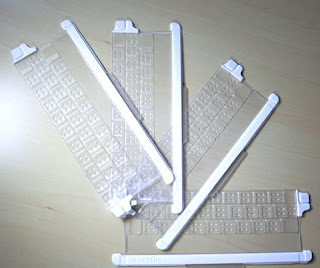Send from Ingrid's iPad @ CoCo's Playhouse
Begin forwarded message:
From: Steven Isaac <steveis@touchfire.com>
Date: April 30, 2012 2:14:08 AM PDT
To: info@touchfire.com
Subject: Touchfire Update #3
Hi, everyone.
Last week we got back our molds for what we hoped would be the start of Touchfire production. We decided to have our factory do a test run of 500 units in order to get warmed up.
The first thing to make was the chins. Half in black:
And half in white:
This was the first time we made white parts, and we were very happy with how they came out.
Let's do a test fit of the magnets and stick on some magnet labels; perfect!
Next, we'll make some storage cases:
And make sure that all the parts that we got from our other manufacturers, like cover clips, are in house and ready to go:
Check, everything is in order.
Ok, now for the fun part - let's make some keyboards. A set of chin and ears are placed in the keypad mold, and then liquid silicone is injected into the mold. And out comes a fully molded keyboard:
They are looking great and work like champs:
The final step is to put the magnets and magnet labels into the completed keyboards, and then we can do final pack-out and start shipping units out the door:
Hey, wait a minute. The magnets no longer fit into the completed keyboards. What's going on here? We've got a problem!
It turned out that all the keyboards we made that day had the same problem; the magnets that fit so well in the freshly molded chin and ears no longer fit in the fully molded keyboard. We sat down and figured out what was going on:
The sidewalls of the magnet receptacles in the finished keyboards were now too small by anywhere from two thousands of an inch to six thousands of an inch on each side. To give you perspective on how big this is, a human hair is four thousands of an inch on average:
These variations are not visible to the naked eye. They occurred this time because we had to place the chin and ears on the opposite side of the keypad tool in our last revision. The chin and ears expand and contract in small, hard to predict ways as they undergo the heat and pressure of the silicone keyboard molding process.
The good news is that these variations are consistent across all keyboards of the same color. However, there are small but significant differences in the variations of the black and white keyboards.
We are very happy with every other aspect of the design, so we have decided not to make any more changes to our molds to address this issue. Instead, we will pursue several low risk approaches in parallel:
1. Try building the chin and ears with a material that has lower heat expansion and contraction characteristics and more consistency between black and white.
2. Reduce the pressure on the chin and ears during the keyboard molding step.
3. Reduce the size of our magnets so that they fit the new size of the magnet receptacles.
We will be trying the first two approaches over the next two weeks. The third approach will take at least five weeks, and it will require replacing the tens of thousands of magnets that we already have in hand at our factory. Needless to say, we will try to avoid this option if at all possible.
We will continue to keep you informed about our progress. Thank you so much for your continued support! Touchfires are coming. And they're going to be great.
Steve and Brad









